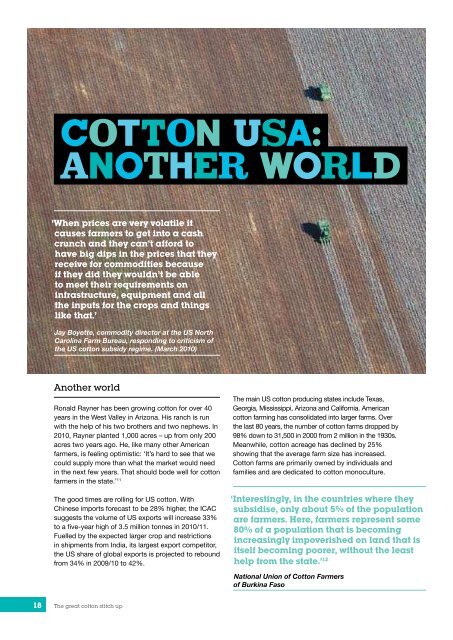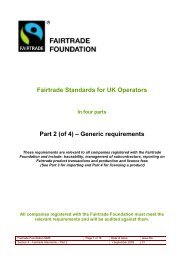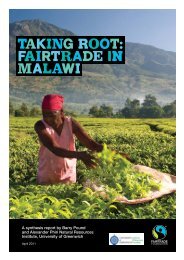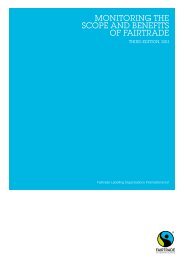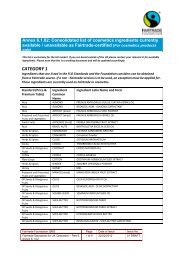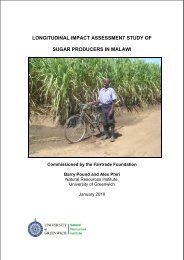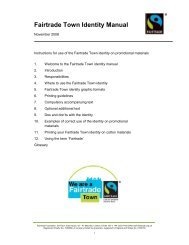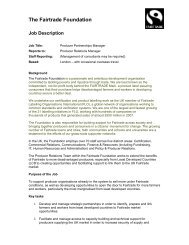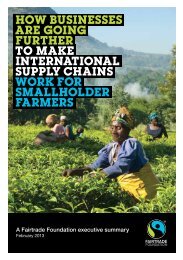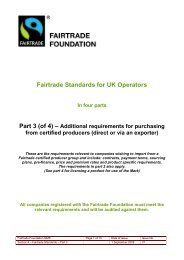the great cotton stitch-Up - The Fairtrade Foundation
the great cotton stitch-Up - The Fairtrade Foundation
the great cotton stitch-Up - The Fairtrade Foundation
Create successful ePaper yourself
Turn your PDF publications into a flip-book with our unique Google optimized e-Paper software.
Cotton USA:<br />
ano<strong>the</strong>r world<br />
‘When prices are very volatile it<br />
causes farmers to get into a cash<br />
crunch and <strong>the</strong>y can’t afford to<br />
have big dips in <strong>the</strong> prices that <strong>the</strong>y<br />
receive for commodities because<br />
if <strong>the</strong>y did <strong>the</strong>y wouldn’t be able<br />
to meet <strong>the</strong>ir requirements on<br />
infrastructure, equipment and all<br />
<strong>the</strong> inputs for <strong>the</strong> crops and things<br />
like that.’<br />
Jay Boyette, commodity director at <strong>the</strong> US North<br />
Carolina Farm Bureau, responding to criticism of<br />
<strong>the</strong> US <strong>cotton</strong> subsidy regime. (March 2010)<br />
Ano<strong>the</strong>r world<br />
Ronald Rayner has been growing <strong>cotton</strong> for over 40<br />
years in <strong>the</strong> West Valley in Arizona. His ranch is run<br />
with <strong>the</strong> help of his two bro<strong>the</strong>rs and two nephews. In<br />
2010, Rayner planted 1,000 acres – up from only 200<br />
acres two years ago. He, like many o<strong>the</strong>r American<br />
farmers, is feeling optimistic: ‘It’s hard to see that we<br />
could supply more than what <strong>the</strong> market would need<br />
in <strong>the</strong> next few years. That should bode well for <strong>cotton</strong><br />
farmers in <strong>the</strong> state.’ 11<br />
<strong>The</strong> good times are rolling for US <strong>cotton</strong>. With<br />
Chinese imports forecast to be 28% higher, <strong>the</strong> ICAC<br />
suggests <strong>the</strong> volume of US exports will increase 33%<br />
to a five-year high of 3.5 million tonnes in 2010/11.<br />
Fuelled by <strong>the</strong> expected larger crop and restrictions<br />
in shipments from India, its largest export competitor,<br />
<strong>the</strong> US share of global exports is projected to rebound<br />
from 34% in 2009/10 to 42%.<br />
<strong>The</strong> main US <strong>cotton</strong> producing states include Texas,<br />
Georgia, Mississippi, Arizona and California. American<br />
<strong>cotton</strong> farming has consolidated into larger farms. Over<br />
<strong>the</strong> last 80 years, <strong>the</strong> number of <strong>cotton</strong> farms dropped by<br />
98% down to 31,500 in 2000 from 2 million in <strong>the</strong> 1930s.<br />
Meanwhile, <strong>cotton</strong> acreage has declined by 25%<br />
showing that <strong>the</strong> average farm size has increased.<br />
Cotton farms are primarily owned by individuals and<br />
families and are dedicated to <strong>cotton</strong> monoculture.<br />
‘Interestingly, in <strong>the</strong> countries where <strong>the</strong>y<br />
subsidise, only about 5% of <strong>the</strong> population<br />
are farmers. Here, farmers represent some<br />
80% of a population that is becoming<br />
increasingly impoverished on land that is<br />
itself becoming poorer, without <strong>the</strong> least<br />
help from <strong>the</strong> state.’ 12<br />
National Union of Cotton Farmers<br />
of Burkina Faso<br />
According to <strong>the</strong> ICAC, <strong>the</strong> world’s leading exporter<br />
is also <strong>the</strong> country with some of <strong>the</strong> highest costs of<br />
production. Whilst <strong>the</strong> average cost of production<br />
is $0.80/lb in <strong>the</strong> USA, <strong>the</strong> cost of production is<br />
$0.35/lb in Benin. <strong>The</strong> US <strong>the</strong>refore subsidises its exports<br />
to be competitive with <strong>the</strong> world’s poorest countries who<br />
also hold a natural competitive advantage in <strong>cotton</strong>.<br />
‘Monster’ uS <strong>cotton</strong> subsidies<br />
<strong>The</strong> contrast between West African and American<br />
<strong>cotton</strong> growers could not be more extreme. While<br />
African farmers lost <strong>the</strong>ir livelihoods during <strong>the</strong> price<br />
crash of 2004, US direct support to <strong>cotton</strong> producers<br />
that same year totalled $3.9bn.<br />
US agricultural subsidies began as a New Deal<br />
response to <strong>the</strong> Great Depression and <strong>the</strong> American<br />
Dustbowl. It is uncertain whe<strong>the</strong>r <strong>the</strong>y were ever<br />
meant to be permanent. During <strong>the</strong> Second World<br />
War, agricultural subsidies were defined as part of<br />
national defence strategy. Today, congressmen admit<br />
that subsidies are necessary for American agriculture<br />
to remain competitive in <strong>the</strong> global economy.<br />
Cotton is situated firmly within <strong>the</strong> context of US<br />
agricultural policy and politics. <strong>The</strong> 2008 Farm Bill<br />
which expires in 2012 was vetoed by President<br />
Bush twice. Both times his veto was over-ridden by<br />
Congress and <strong>the</strong> bill passed into law in June 2008.<br />
<strong>The</strong> 2008 Farm Bill subsidies – a five year programme<br />
worth $288bn – were supposedly designed to move<br />
<strong>the</strong> sector towards more market-oriented decisions<br />
about productions levels. However, <strong>the</strong> 2008 Bill<br />
continued <strong>the</strong> practice of countercyclical payments,<br />
marketing assistance loans, and loan deficiency<br />
payments, which <strong>the</strong> Department of Agriculture claims<br />
do not encourage over production. American farmers<br />
remain insulated from <strong>the</strong> fluctuations of global<br />
<strong>cotton</strong> prices.<br />
Inside uS Congress: signing<br />
cheques to <strong>the</strong> <strong>cotton</strong> lobby<br />
<strong>The</strong> Senate Committee on Agriculture is <strong>the</strong> supreme<br />
power that maintains <strong>the</strong> American <strong>cotton</strong> subsidy<br />
regime. It consists of Senators from <strong>the</strong> <strong>cotton</strong>producing<br />
states of Georgia, Mississippi, Texas and<br />
Arkansas. Agricultural subsidies provide an important<br />
source of income for <strong>the</strong>ir constituents.<br />
Until <strong>the</strong> 2010 US mid-term elections, <strong>the</strong> Democrat<br />
Chair of <strong>the</strong> committee was Blanche Lincoln from<br />
Arkansas and <strong>the</strong> ranking Republican member, Saxby<br />
Countercyclical payment:<br />
a licence to print money<br />
Countercyclical payments (CP) are based upon<br />
historical, not current, production rates and do<br />
not even require <strong>the</strong> farmer continue to plant that<br />
historical crop. CP allows farmers more flexibility<br />
in choosing <strong>the</strong>ir crops, which in <strong>the</strong>ory should<br />
result in a move away from <strong>cotton</strong> production.<br />
<strong>The</strong> lower <strong>the</strong> current commodity price is from<br />
<strong>the</strong> historical price, <strong>the</strong> higher <strong>the</strong> countercyclical<br />
payment. While <strong>the</strong>re is no direct tie to production,<br />
<strong>the</strong>re is similarly no market incentive not to produce<br />
when <strong>the</strong>re is an oversupply and falling prices.<br />
Chambliss represents Georgia, America’s second<br />
biggest <strong>cotton</strong> state after Texas. <strong>The</strong> rest of <strong>the</strong><br />
committee members come from heavy agriculture and<br />
meat producing states. <strong>The</strong>re is a similar make-up on<br />
<strong>the</strong> House of Representatives sub-committee.<br />
Because <strong>cotton</strong> has such a long supply chain,<br />
<strong>the</strong> <strong>cotton</strong> lobby’s interests include an array of<br />
middlemen. <strong>The</strong> National Cotton Council of America<br />
(NCC) represents farmers, ginners, warehousers,<br />
<strong>cotton</strong>-seed sellers and manufacturers. <strong>The</strong>y regularly<br />
appear before <strong>the</strong> House sub-committee stressing<br />
‘stable farm policy’ on behalf of <strong>the</strong> entire industry. 13<br />
Similarly, each <strong>cotton</strong> growing state has regional<br />
<strong>cotton</strong> associations to advocate <strong>the</strong> interests of<br />
farmers and ginners. For example, <strong>The</strong> Plains Cotton<br />
Growers of Texas monitors national policy to advise<br />
farmers when to express <strong>the</strong> appropriate amount of<br />
outrage to <strong>the</strong>ir local politicians.<br />
<strong>The</strong> size of <strong>cotton</strong> subsidies in <strong>the</strong> United States certainly<br />
appears to confirm that political funding and extensive<br />
lobbying generates significant returns for farmers.<br />
WTo confirms united States use<br />
‘prohibitive’ <strong>cotton</strong> subsidies<br />
In 2002, as world attention focussed on <strong>the</strong> billions<br />
of dollars of <strong>cotton</strong> subsidies paid by <strong>the</strong> US<br />
government to its farmers, Brazil used <strong>the</strong> WTO<br />
dispute settlement system to file a legal complaint<br />
against America. <strong>The</strong> emerging South American<br />
superpower argued that US <strong>cotton</strong> subsidies<br />
violated agreements made during <strong>the</strong> previous global<br />
trade deal, <strong>the</strong> Uruguay Round and that US <strong>cotton</strong><br />
subsidies harmed Brazilian <strong>cotton</strong> growers.<br />
In a long drawn out legal tussle under <strong>the</strong> auspices<br />
of <strong>the</strong> WTO, Brazil in 2009 won <strong>the</strong> right to retaliate<br />
against <strong>the</strong> US. <strong>The</strong> WTO condemned <strong>the</strong> US for<br />
18 <strong>The</strong> <strong>great</strong> <strong>cotton</strong> <strong>stitch</strong> up<br />
<strong>The</strong> <strong>great</strong> <strong>cotton</strong> <strong>stitch</strong>-up 19


